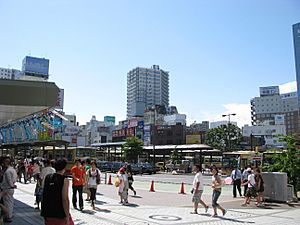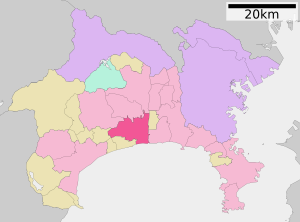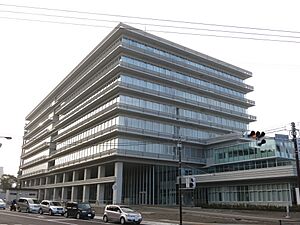Hiratsuka facts for kids
Quick facts for kids
Hiratsuka
平塚市
|
|||
|---|---|---|---|

Hiratsuka
|
|||
|
|||

Location of Hiratsuka in Kanagawa Prefecture
|
|||
| Country | Japan | ||
| Region | Kantō | ||
| Prefecture | Kanagawa | ||
| First official recorded | late 3rd century (official) | ||
| Town settled | April 1, 1889 | ||
| City settled | April 1, 1932 | ||
| Area | |||
| • Total | 67.88 km2 (26.21 sq mi) | ||
| Population
(April 1, 2021)
|
|||
| • Total | 257,316 | ||
| • Density | 3,790.75/km2 (9,818.0/sq mi) | ||
| Time zone | UTC+9 (Japan Standard Time) | ||
| – Tree | Camphor Laurel | ||
| – Flower | Dianthus | ||
| – Bird | Egret | ||
| Phone number | 0463-23-1111 | ||
| Address | 9-1 Sengenchō, Hiratsuka-shi, Kanagawa-ken 254-8686 | ||
Hiratsuka (平塚市 (Hiratsuka-shi)) is a city located in Kanagawa Prefecture, Japan. As of April 1, 2021, about 257,316 people live there. The city covers an area of 67.88 square kilometers (about 26.21 square miles).
Hiratsuka is known for its beautiful location near the sea and its interesting history. It is also famous for its annual Tanabata festival, which is a big celebration.
Contents
Geography and Location
Hiratsuka is in the Shōnan area of Kanagawa Prefecture. It sits on the west side of the Sagami River and faces Sagami Bay to the south. The city has flat areas near the river and some hills to the west.
It's located almost exactly halfway between the big city of Tokyo and the famous Mount Fuji. This makes it a great spot for both city life and enjoying nature.
Neighboring Cities and Towns
Hiratsuka is surrounded by several other places in Kanagawa Prefecture:
- Atsugi
- Chigasaki
- Hadano
- Isehara
- Nakai
- Ninomiya
- Oiso
- Samukawa
Climate in Hiratsuka
Hiratsuka has a climate with warm summers and cool winters. There is usually not much snow. The average temperature for the year is about 14.6°C (58.3°F).
The city gets a lot of rain, especially in September. August is usually the warmest month, with temperatures around 25.2°C (77.4°F). January is the coldest, with temperatures around 4.4°C (39.9°F).
Population Growth
The number of people living in Hiratsuka grew quickly in the late 1900s. However, the population has stayed about the same in the 2000s.
- 1950: 49,638 people
- 1960: 108,279 people
- 1970: 163,671 people
- 1980: 214,293 people
- 1990: 245,950 people
- 2000: 254,633 people
- 2010: 260,780 people
- 2020: 258,422 people
History of Hiratsuka
People have lived in the Hiratsuka area since ancient times. Records from the Nara period (710-794 AD) mention this area.
During the Heian period (794-1185) and Kamakura period (1185-1333), the land was divided into large estates called shōen. These were controlled by different samurai families. Later, in the Sengoku period (1467-1615), there were battles between powerful clans here.
After 1590, the area came under the control of Ieyasu Tokugawa. He built a summer palace called the Nakahara Goten in 1596. This is now the site of a local elementary school.
Hiratsuka became an important post town called Hiratsuka-juku on the Tōkaidō road. This road connected Edo (old Tokyo) with Kyoto. Hiratsuka was the 7th station on this route. It was often shown in famous Japanese artworks called ukiyo-e, by artists like Hokusai and Hiroshige.
Hiratsuka officially became a town on April 1, 1889. It grew and became a city on April 1, 1932.
During World War II, Hiratsuka was home to factories that made military supplies. Because of this, the city was heavily damaged by bombing on July 16, 1945.
After the war, the city quickly rebuilt itself. It grew by joining with nearby villages in the 1950s. In 2001, Hiratsuka became a "special city." This means it has more independence in how it is governed.
The current mayor of Hiratsuka is Katsuhiro Ochiai. He was first elected in 2011. Before becoming mayor, he served on the Hiratsuka city council.
Economy and Industries
Hiratsuka has a varied economy. Some money comes from a cycling velodrome where people place bets. Many industries also have factories in the city's industrial parks.
Big companies like Nissan Shatai (car parts), Yokohama Rubber Company (tires), Canon (cameras and printers), and Pilot (pens) have plants here. The famous Namiki pens are made in Hiratsuka.
Many people who live in Hiratsuka also travel to work in bigger cities like Yokohama and Tokyo. They are drawn to the "Shōnan lifestyle," which means enjoying the coastal area.
Education in Hiratsuka
Hiratsuka has many schools for children and young adults.
- There are 28 public elementary schools.
- There are 15 public middle schools.
- The city has five public high schools and one private high school.
- There are also four special education schools for students with disabilities.
For higher education, Hiratsuka has a private junior college. It also has branch campuses of Kanagawa University, Shoin University, and Tokai University.
Transportation
Hiratsuka is well-connected by trains and roads.
Railway
![]() JR East trains serve Hiratsuka:
JR East trains serve Hiratsuka:
- Tōkaidō Main Line
- Shōnan Shinjuku Line
- The main station is Hiratsuka.
Highways
Several important roads pass through or near Hiratsuka:
 Odawara-Atsugi Road
Odawara-Atsugi Road National Route 1 (connects to Tokyo or Kyoto)
National Route 1 (connects to Tokyo or Kyoto) National Route 129 (connects to Sagamihara)
National Route 129 (connects to Sagamihara) National Route 134 (connects to Yokosuka via Kamakura)
National Route 134 (connects to Yokosuka via Kamakura) National Route 271 (connects to Atsugi or Odawara, this is a toll road)
National Route 271 (connects to Atsugi or Odawara, this is a toll road)- Shinshōnan Bypass
Fun Things to See and Do
Hiratsuka has several places that visitors enjoy:
- Tanabata festival: A famous summer festival with colorful decorations.
- Shonan Bellmare: A professional soccer club that plays at Hiratsuka Athletics Stadium.
- Kana Garden: A beautiful garden to explore.
- Hiratsuka Hachiman-gu: An important Shinto shrine.
- Hiratsuka Museum of Art: A place to see local and national art.
Sister Cities
Hiratsuka has special friendships with other cities around the world and in Japan. These are called "sister cities."
 Alytus, Lithuania (since 2017)
Alytus, Lithuania (since 2017) Hanamaki, Iwate, Japan (since April 27, 1984)
Hanamaki, Iwate, Japan (since April 27, 1984) Izu, Shizuoka, Japan (since February 6, 2013)
Izu, Shizuoka, Japan (since February 6, 2013) Kaunas, Lithuania (since November 25, 2023)
Kaunas, Lithuania (since November 25, 2023) Lawrence, Kansas, United States (since September 21, 1990)
Lawrence, Kansas, United States (since September 21, 1990) Takayama, Gifu, Japan (since October 22, 1982)
Takayama, Gifu, Japan (since October 22, 1982)
Famous People from Hiratsuka
Many talented people have come from Hiratsuka, including:
- Yukari Fukui – a voice actress
- Yamanashi Hanzō – a general and politician
- Lalla Hirayama – a TV host, actress, and dancer
- Michael Hora – a former child actor
- Michiko Kawai – an actress
- Yuki Kubota – an actress and model
- Phongchi – a Japanese idol
- Izumi Sakai – a singer and songwriter, known from the band Zard
- Hokuto Shimoda – a professional soccer player
- Mitsunori Takaboshi – a racing driver
Images for kids
See also
 In Spanish: Hiratsuka para niños
In Spanish: Hiratsuka para niños









